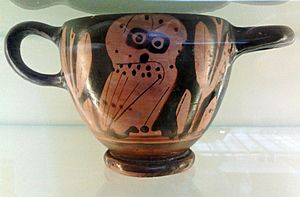Cotyla facts for kids
The cotyla or cotyle was an ancient unit of measurement used by the Greeks and Romans. It was a way to measure how much liquid or dry goods a container could hold. Think of it like a cup or a bowl.
The cotyla was also the name for a type of ancient Greek vase. These vases looked a bit like a skyphos (a deep cup) but were shaped more like a kantharos (a cup with tall handles).
Contents
What Was the Cotyla?
The cotyla was an important unit of measurement in classical antiquity. It was used in both Ancient Greece and Ancient Rome. The Greeks sometimes called it hemina, while the Romans used names like tryblion or hemina.
How Big Was a Cotyla?
A cotyla was equal to half of a larger unit called a sextarius. It held six smaller units called cyathi. To give you an idea, one cotyla was nearly half a pint in English measurement. This means it was a fairly small amount, useful for everyday measurements.
How Was the Cotyla Used?
Ancient doctors often used the cotyla to measure liquids. Their cotyla vessels had lines marked on the side, just like modern measuring cups or beakers. They used these marks to measure exact amounts of fluids, especially oil, for medicines or other purposes.
Measuring Oil with a Cotyla
Imagine a special vessel shaped like a cube or a cylinder. This vessel held exactly one cotyla of liquid. It was divided into twelve equal parts, marked by lines on its side. The entire vessel was called a litra. Each of the twelve small parts was called an ounce (uncia).
When measuring oil, this vessel could hold nine ounces of oil by weight. This meant that the weight of the oil compared to the number of parts it filled in the measure was 9 to 12, which can be simplified to 3 to 4.
Cotyla for Dry Goods
The cotyla wasn't just for liquids! Historians like Thucydides tell us that it was also used to measure dry things, like bread. So, people might talk about two cotylae of wine or two cotylae of bread, showing its use for both liquids and solids.
Images for kids
-
Attic Cotyla cup with an owl (5th century BC), National Museum in Warsaw.
See also
 In Spanish: Cótila para niños
In Spanish: Cótila para niños



